8.1 Problem Statement
Globalization has created a highly competitive business environment in which corporations all over the world, large and small, are being forced to generate new business strategies, to evolve a global vision. It is now becoming essential for companies to get away from a purely domestic approach and to take a global approach to business. The potential rewards of a global approach to business are tremendous as are the risks.
Information is becoming increasingly important in every kind of business because of the ever-increasing speed with which business is being conducted, the need to monitor and follow competitors, changes in demographics, the increasing complexity of the business environment and the high levels of competition.
Information is particularly important in today's highly complex and dynamic world of international business. Complex and dynamic because of the many alternative business options that are available and the external factors that influence business decisions, many of which a company has limited or no control over.
The nature of information needed by decision makers dealing with international markets depends on the nature of their operations and the stage in the decision making process.
The criticality of the need for accurate information is much higher (and the resources available for its collection much lower) in the early stages of the decision making process such as when a company is attempting to decide which country to target and/or what product/service to introduce. Typically, once a company has actually started operations in or decided on a specific country, the resources and infrastructure will be available to generate accurate and reliable information.
For country selection, many companies first employ some form of scanning technique, comparing countries on the basis of a few broad variables. In order to do this, decision makers need to have diverse kinds of information which typically needs to be obtained from a variety of sources.
Business research is undertaken in order to reduce the uncertainties in the decision making process and to expand or narrow the alternatives under consideration and it is therefore important that the data be accurate and reliable. No source of information is perfect and some are more likely to have reliability problems than others.
The most commonly used method for determining the authenticity of information is to look at the source of the data. Looking at who originally collected the data, the purpose of the data collection and how the data was collected often gives indications of how reliable the information is. Another consideration is the date when the data was collected.
There is usually a trade-off between the quality of information and the cost of its acquisition. The monetary cost of business research is relatively easy to measure but the time cost is often difficult to determine. But it would appear that the time cost can be very high, particularly in the area of international business, because of the wide range of information needed, the number of sources that have to be tapped to get it and the effort that has to be taken to ensure authenticity of data.
Thus, there seems to be a need for a resource to deliver authentic and accurate information specifically aimed at the needs of decision makers involved in international business.
8.2 Solution Domain
Information sources can be broadly classified based on the means of delivery as conventional (print media) and on-line (electronic media).
Some of the problems with conventional sources of information include currentness of information, difficulty and time involved in physically acquisition, cost and usability of information in terms of conversion to electronic format.
On-line information service providers overcome some of these problems but suffer from limitations in terms of membership requirement for access, difficult user interfaces requiring search expertise, high cost of membership, charges based on connect time and specialized nature of individual sources.
The Internet seems to have potential for providing a means of delivery of a solution to the problem defined in the previous section. This not only because of its increasing reach and universal accessibility but because of the tremendous resources that exist on it. It also offers potential economies resulting from the fact that its protocols support multiple simultaneous users and sharing of bandwidth resources.
Peters (1993) suggests three possible strategies for product and service development on the Internet.
First, there are modernizing strategies (the most common) where the Internet is used as a means to improve the way something was done "well enough" before the Internet came into existence. Examples are the use of electronic mail and file transfer as substitutes for paper mail and delivery services.
Second, there are the innovating strategies (increasingly prevalent) where the Internet is used to solve problems to which effective solutions never existed before. Most such strategies aim to provide integrated access to information and services and Archie, Gopher and the World Wide Web are familiar examples of this type of effort.
Third, there are the transforming strategies which aim to solve problems that were not known to exist earlier but which have, in a sense resulted from the existence of the Internet itself.
The present problem appears to fall in the second category. Two possible approaches appear to exist for using the Internet to deliver a solution to the information needs of international business:
- Compile a database of resources relevant to international business available on the Internet and create a front end interface to allow access to these in a manner that is meaningful to the end user.
- Create and maintain a dedicated database of information relevant to international and provide access to it through the Internet.
The first approach has significant disadvantages stemming from the chaotic nature of the Internet. In many ways the Internet is like a church: it has its council of elders, every member has an opinion about how things should work, and you can either take part or not. It's your choice. The Internet has no president, chief operating officer, or Pope. The constituent networks may have presidents and CEO's, but that's a different issue; there's no single authority figure for the Internet as a whole. (Krol 1994).
This chaotic nature of the Internet makes it extremely difficult to find resources on it. One has to have plenty of time on ones hands to be able to take on the task of finding information on the Internet. The user is faced with a choice of spending a lot of time searching the network (with no guarantee of success) or finding other, sources of information. And the increasing time pressures resulting from the highly competitive global business environment often dictate the latter choice.
Also, the changing nature of the Internet means that sites move and URLs change and it can be next to impossible to ensure that sources are still available when needed. This problem is confirmed by the findings of the Fourth WWW User Survey conducted by the Graphic, Visualization & Usability Center (GVU) at Georgia Tech (http://www.cc.gatech.edu/gvu/user-surveys/) which listed problems users faced with the World Wide Web- not being able to find a page that they know is out there (34.5%), not being able to organize the pages & information they gather (25.8%) and not being able to find a page once visited (23.7%).
Besides the problems of resource discovery mentioned above and discussed in an earlier chapter, information sources presently available on the Internet suffer from limitations in terms of:
- Reliability
- Currentness
- Rights of use
- Unsuitable formatting for subsequent use.
Hence, it would seem that the second approach, to create and maintain a dedicated database of information relevant to international business and provide access to it through the Internet, would be more effective. An information resource accessible through the World Wide Web would take advantage of the reach, accessibility and economies of Internet technologies, while providing a more interactive environment (using the Web's hypertext capabilities) that can handle and deliver various kinds of data (such as text, graphics, audio and video).
8.3 The WorldInfo Prototype
The proposed solution is called WorldInfo and a prototype was built and installed on the World Wide Web server at ACCAD (Advanced Computing Center for the Arts and Design) at the Ohio State University at http://www.cgrg.ohio-state.edu/~ngopalan/thesis.html.
WorldInfo is intended specifically for use by those involved in decision making relating to the design, development, manufacturing and marketing of products and services for global markets.
The key features of the concept are:
- Universal access through the World Wide Web
- Convenient, user friendly interface
- Structuring of information suited to user needs
- Guarantee of authenticity, currentness, reliability and rights of use
- Charges based entirely on information retrieved
- Usability for occasional visitors as well as members
- Choice of formats and platforms for information retrieval
Intended to be truly a one-stop shopping digital resource, WorldInfo will offer information from various sources through a user friendly, interactive interface. It will be a truly integrated information resource offering not only text based information but also a library of visual, audio and video documentation.
Users will have a choice of formats in which to receive the information as well as the means of delivery. They can choose to view information on-screen, receive files as Email attachments, download the material directly through FTP, or have it sent to through regular mail or courier channels.
Besides convenient access, WorldInfo will offer a guarantee of authentic, accurate and reliable information. Because of the importance of accurate and authentic information to the intended user group, only information from reliable information providers will be made available. All documents will come with full bibliographic details. Users will also be provided with the rights to use this material through a licensing agreement that they will have to enter into.
WorldInfo is intended to be a commercial service which will generate its revenue from payments by users for the information it provides. This approach to commercial feasibility may appear debatable because most of the World Wide Web based information ventures (such as Yahoo and Lycos) survive on advertising revenue from sponsors rather than charging the user for services. In fact, according to the Fourth WWW User Survey conducted by the Graphic, Visualization, & Usability Center (GVU) at Georgia Tech (http://www.cc.gatech.edu/gvu/user-surveys/), 31.8% of users stated outright that they would not pay for access to WWW sites.
However, most users (58.7%) reported that their willingness would depend on both the cost of access as well as the quality of the material provided which would tend to indicate that there could be potential for "pay per use" information resources such as WorldInfo. In fact, there is a trend towards this as many popular Web sites such as Time-Warner's Pathfinder site, Wall Street Journal's Electronic Edition and USA TODAY's archives will soon be charging for access. And Playboy has been charging for access for quite a while. (Kim 1996).
Users will have a choice of billing and payment options. They can set up an account and receive a monthly invoice. Or they can set up a temporary account and pay for information through charges to their credit cards. All payment related transactions will be handled through a secure server. In the future, electronic cash will also be usable as a method of payment.
The WorldInfo prototype is optimized for Netscape Navigator 2.0. This is to take advantage of its frames capabilities which allow more design flexibility in terms of improving the user interaction. Frames break up the Navigator window into sections, which the user can scroll through individually. Actions (such as selecting a link) in one window or frame can cause responses in other frames. This is a more effective way to view information and offers the ability to create navigational toolbars that always stay visible, even if the contents of another frame changes. (See Figure 8.1).
This downside of this decision is that it can presently be accessed only with Netscape Navigator (2.0 or higher). This may be justified by the extreme popularity of Netscape compared to the other browsers. The studies cited in an earlier chapter indicate popularity figures ranging from 70% to 85%. Another justification for this approach is the fact that many innovative HTML tags introduced by Netscape have become de-facto standards as other browsers adopt it- this may suggest that a concept like frames will soon be come a universal standard.
However, an information resource such as the one under consideration needs to be universally accessible in order to maximize usage (and make commercial sense). There are two possible strategies to achieve this:
- Provide alternative versions accessible by browsers which do not support frames. This has the disadvantage of doubling the maintenance effort but would allow the full capabilities of all kinds of browsers to be exploited because the different versions would be totally independent.
- Integrate both non-frames and frames versions into each page. This is possible by using the NOFRAMES tag which allows each page to have a non-frames version which is recognized by other browsers but is ignored by Netscape Navigator 2.0. This has the advantage of reducing maintenance effort but would probably require some compromise in terms of reconciling the capabilities of different kinds of browsers.
While the frames capability of Netscape Navigator 2.0 does offer significant advantages in terms of interface design, it also has limitations in terms of moving back and forth within a frame. The Back and Forward buttons on the menu bar only go back or forward between whole framesets. Moving within a frame requires use of the popup menu associated with the mouse button (learning the use of which can be a problem particularly for novice users). There is a fix in the pipeline in the next version of Netscape Navigator (code named Atlas) but this is still in the pre-release testing stage. In the present version of the prototype, this has been worked around using a three-fold strategy:
- Use of separate framesets for each main section of the prototype.
- Provision of numerous Back links for navigation within a frame.
- Duplication of documents that are accessed from multiple sections of the site.
This is not a very efficient solution because it requires more server transactions and loading of files. A better implementation of the navigation scheme should be possible after the Atlas version of Netscape is available as an official release.
One of the key navigation features of the WorldInfo prototype is the provision of a Related Links section (described in detail in the following section) which provides links to areas that are related to the user's current location in the site. These links change throughout the site. This is presently implemented by using multiple framesets for each section of the prototype. This again is not a very efficient solution because it requires more server transactions and loading of files. The same functionality could be achieved using either server side push or a client side script. However, due to lack of time this could not be implemented.
Due to constraints of time and resources, only limited functionality and content has been built into the prototype. For example, the Search section of the site is not functional and only limited content on the Physical Environment in China has been provided. However, it is hoped that the levels of functionality and content provided would be adequate for potential users to get a sense of what information WorldInfo would provide and how it would work. Towards this end, each category of the information classification has a description of the kind of information that would be provided in that area. In order to provide a good sense of the user interaction, actual download capabilities for the information provided has been implemented.
8.4 System Description
The entry point to WorldInfo is shown below.
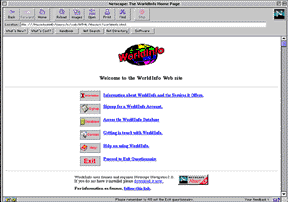
Figure 8.1 WorldInfo Main Page
The main page provides links to the main sections of WorldInfo i.e.:
- Information, which provides information about WorldInfo and its services
- Signup, which allows users to signup for a WorldInfo account
- Contact, which allows users (and prospective users) to contact WorldInfo
- Help, which provides help information, answers typical user questions etc.
- Database, which provides access to the WorldInfo database
Brief descriptions of each section are provided to give first time visitors an idea of the overall organization of WorldInfo. Visitors are informed that they need to have Netscape Navigator 2.0 installed to use WorldInfo and a link provided to Netscape's Web site to allow them to download it.
Except for the entry page, all other sections use frames. The frames pages have four basic functional areas (shown in Figure 8.2 below) :
- Navigation Bar
- Related Links
- Title
- Interaction Area
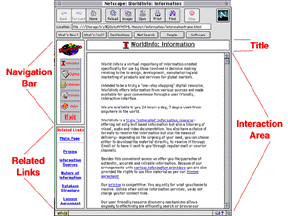
Figure 8.2 WorldInfo Frame Structure
The screen is split vertically into two major areas: a narrow left column which contains navigation related links and a broad right column which is the main content area.
The left column is again divided into two parts. The upper half remains unchanged throughout the site and contains links to the main sections of the site. The lower half is devoted to links to related areas that might be of interest to the user. These links change depending on the user's current location within the site.
The right column is again divided into two parts: a narrow title bar at the top and a large interaction area below. The title naming scheme is hierarchical in order to give the user a sense of how deep he or she is within the structure of the site. Thus, if the user is in the Browse option of the Database section of WorldInfo, the title would be WorldInfo: Database: Browse. The title also functions as a link to a Disclaimer message which defines the purpose of the prototype. The interaction area is the main display area for the site.
As mentioned earlier, WorldInfo consists of five main sections:
- Information
- Signup
- Contact
- Help
- Database
The Information section contains details of WorldInfo and the services it provides. It also has links to pages with information on pricing, information sources, types of information available, structure of the database and a license agreement.
The Signup section allows users to signup for two types of accounts: a Permanent Account or a Temporary Account. A permanent account gives users the convenience of a monthly itemized invoice besides a special discounted pricing. A temporary account allows users to pay for information on-line with a credit card. The Signup transaction will be handled through a secure connection though this is not implemented in the prototype.
The Contact section has separate links for account information, problems and suggestions. It also has a form allowing visitors to request additional information to be mailed to them.
The Help section provides help information. This will include details of the organization of the site and the database, navigation tips and tips for searching for and locating information.
The Database section allows users to choose a method of accessing the database. Two basic choices will be available: Browsing and Searching. Access to this area will be open only to members and will be password protected.
Screen shots of these sections appear in the following pages (Figures 8.3 thru 8.7).
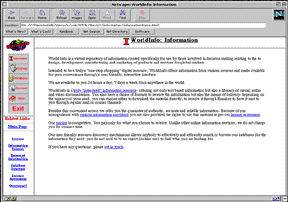
Figure 8.3 WorldInfo Information Page
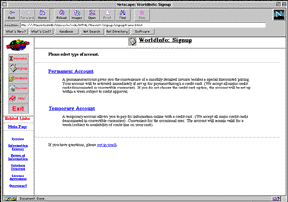
Figure 8.4 WorldInfo Signup Page
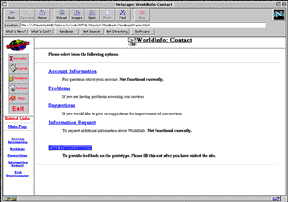
Figure 8.5 WorldInfo Contact Page
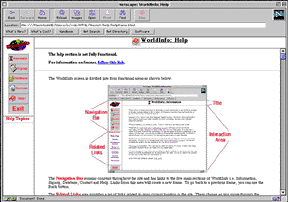
Figure 8.6 WorldInfo Help Page
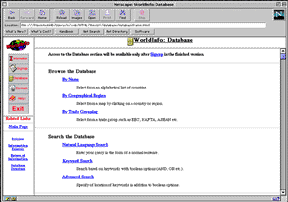
Figure 8.7 WorldInfo Database Page
The Database page has three search options available offering different levels of control: Natural Language, Keyword and Advanced.
- Natural Language Search allows queries in the form of a normal sentence.
- Keyword Search allows searching based on keywords with Boolean options (AND, OR etc.).
- Advanced Search allows specification of the location of keywords in addition to Boolean options.
The interfaces of these search options are shown in Figures 8.8 thru 8.10 in the following pages.
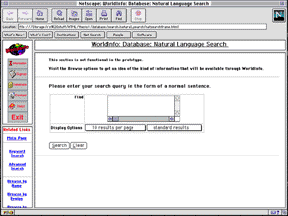
Figure 8.8 WorldInfo Natural Language Search Page
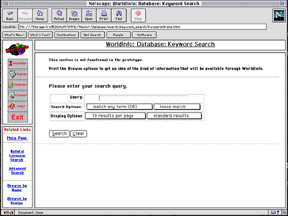
Figure 8.9 WorldInfo Keyword Search Page
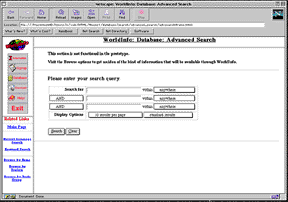
Figure 8.10 WorldInfo Advanced Search Page
The Database page also has a Browse option which allows selection of a country in one of three ways.
- Browse by Region allows the user to select a country by clicking on a map. Starting with a world map, it allows zooming in on a continent and then on to a specific country.
- Browse by Name allows selection of a country from an alphabetical list of countries.
- Browse by Trade group allows the user to select a trade group such as NAFTA or ASEAN and then to select a country from among its members.
The interfaces of these browse options are shown in Figures 8.11 thru 8.13 in the following pages.
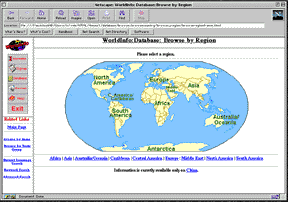
Figure 8.11 WorldInfo Browse by Region Page

Figure 8.12 WorldInfo Browse by Name Page
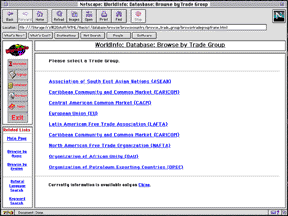
Figure 8.13 WorldInfo Browse by Trade Group Page
Users can arrive at a country page through any of the Browse or Search options described previously. A sample country page appears below.
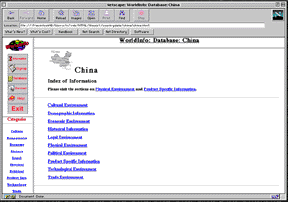
Figure 8.14 WorldInfo Country Page
Each country will have information in the following categories:
Cultural Environment
Aesthetic Preferences
Language
Manners and Customs
Religion
Social Attitudes
Values and Attitudes
Demographic Information
Age Distribution
Consumption Patterns
Distribution of Population
Family Size
Income Distribution
Per Capita Income
Population Trends
Economic Environment
Economic Growth
Economic System
Foreign Exchange System
GNP and GDP Trends
Inflation Trends
Per Capita Income
Purchasing Power
Historical Information
Legal Environment
Dispute Resolution
Financial Flow Regulation
Intellectual Property
International Treaties
Legal System
Ownership Regulation
Taxation Structure
Physical Environment
Area
Climate
Environment
Land and sea boundaries
Location
Maps
Natural resources
Terrain
Political Environment
Diplomatic Issues
History
International Relationships
Political System
Stability
Product Specific Information
Described in detail below
Technological Environment
Availability of Technology
Distribution Channels
Infrastructure
Manufacturing Capabilities
Raw Materials
Training of Workforce
Wage Levels
Trade Environment
Balance of Payments
Business Options
Duties
Export Restrictions
Import Restrictions
Repatriation of Profits
Subsidies
Tariffs
The above categories of information (as well as the Product Information categories below) were arrived at based on a perusal of business and design journals, magazines and textbooks.
All the categories lead to an index of items (with pricing) available in that category and a link to an order form. The order form provides users with choices of delivery method (view on screen, download by FTP, receive as Email attachment or conventional mail/courier), platform (PC, Macintosh or UNIX) and format (text, pdf or rtf for text documents, jpeg, tiff or pict for graphics etc.).
A sample Product Information page is shown below.
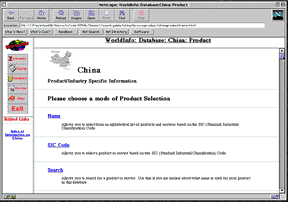
Figure 8.15 WorldInfo Product Information Page
In the case of Product Specific Information, four alternative means of product selection will be available: By Name, By SIC Code, By Search, From Classified List.
- Product selection By Name allows the user to select from an alphabetical list of products.
- The SIC Code option provides for product selection based on its SIC Code.
- In the case of Classified List, the products are categorized into major groups such as Household Appliances, Machine Tools, Medical Equipment, Office Equipment, Transportation etc.
- If none of these options work, the user may also choose to Search the database.
The interfaces of these product selection options are shown in Figures 8.16 thru 8.19 in the following pages.
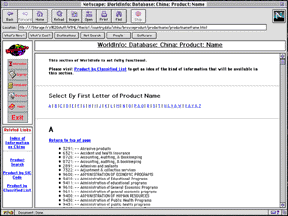
Figure 8.16 WorldInfo Product by Name Page
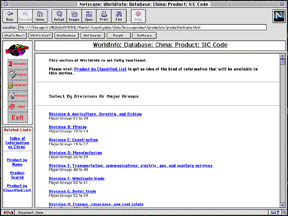
Figure 8.17 WorldInfo Product by SIC Code Page
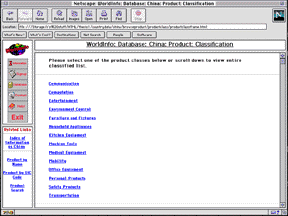
Figure 8.18 WorldInfo Product by Classified List Page
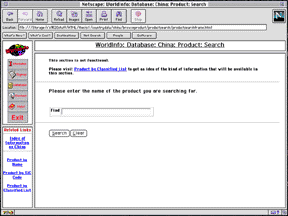
Figure 8.19 WorldInfo Product Search Page
Existing Products
Manufacturers
Specifications
Production Volumes
Retail Prices
Pictures of Products
Related Products
Related Services
Standards/Legislation
Performance Standards
Safety Standards
Quality Standards
Taxation Structures
Energy Sources
Availability
Cost
Reliability
Infrastructure/Technology
Service/Repair Capabilities
Local Manufacturing Capabilities